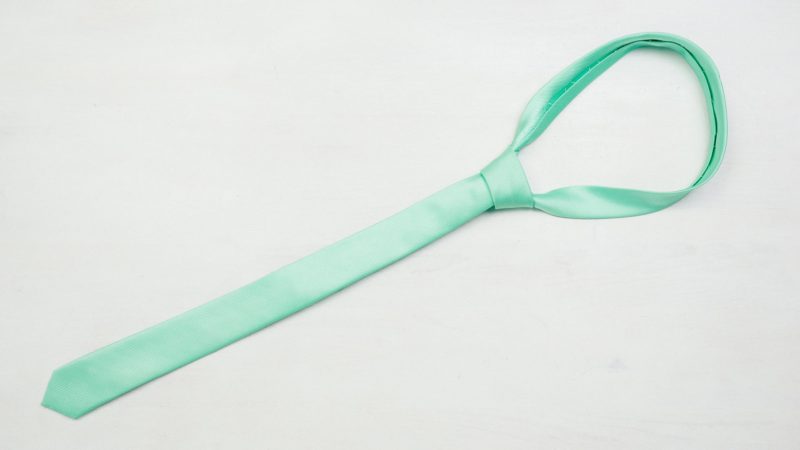A tie is a sign of solidity and good manners. But after purchasing this attribute, the question arises of how to tie a narrow tie in order to simultaneously follow the fashion and show your accuracy.
Material Content:
The classic way to tie a narrow tie
The classic way is available to everyone because of its simplicity.
It is often called the "Four", as a step-by-step instruction for tying consists of only 4 points:
- The wardrobe item is placed above the collar in such a way that as a result the product receives a suitable length, then the largest part is superimposed on the smallest so that the narrow one “looks” to the left.
- The wide part bends and goes to the right side. In this case, a loop is necessarily formed along the diameter of the smaller part.
- The wide end is dragged from the bottom up, into the neck of the loop.
- It is threaded into the newly formed loop and tightened.
The classic technique will suit everyone and fit into any style, so it does not go out of style. But at the same time, there are other types of nodes used with various models of clothing.
Step-by-step instructions with diagrams
The number of tie knots goes beyond one dozen. Some of them are traditional, but there are catchy and unusual. In order to supplement your image with a new detail every day, you should master at least a few of them.
The figures illustrate in detail the process, no matter how confusing it may seem.
In the English style
Another name for this method is Windsor, in honor of the representative of England. Suitable for officialdom, and for a friendly or family holiday, which promises to end violently.The thing is that this knot can be loosened in one motion, without removing and not untying the whole tie. Extremely comfortable.
The only caveat - initially the accessory must be longer than usual, so that later it does not look comically short:
- Mentally divide the product so that the middle part has a size of not more than 30 cm, the smaller end is shorter in width, the larger is longer.
- Cross them.
- Pull the large edge through the neck loop from the bottom up.
- Again, lower it and wrap it around the short edge so that the long “points” to the right, then toss it in the opposite direction through the loop (from top to bottom).
"Windsor" is voluminous in itself, therefore it is combined only with a thin tie. Dense fabric or large width will make the construction bulky.
Another way, “Victorian,” also came to us from England. It got its name in honor of the era of its popularity - the XIX century, the reign of Queen Victoria.
His second name is “Four with a half / a half”, but not because it looks like the classic “Four”, but because of wrapping one end of the other 4 times:
- Throw the wide edge over the narrow one, wrap around it 4 times in the direction from left to right.
- Pass through the free space between the collar and tie.
- Lower down and fix the "structure".
In youth
You can tie a narrow tie stylishly and beautifully using the Van Wake method, which is an unusual detail that was invented and popularized by the artist girl Lisa Van Wake. The result does not look strict - a detail for which young people love it.
The color of the accessory fabric is better to choose light, so that the unusual winding clearly stands out, and does not merge, as it would with a dark fabric:
- As usual, the wide end fits over the narrow one, then wraps around the last one. Subtleties of the method: wound three times and not very tight (there should be a small gap).
- The wide end is threaded first through the collar loop from bottom to top, then pulled from top to bottom in the gap from step 1, as a result of which the winding remains from above.
- The knot is tightened and corrected.
Another way that is not suitable for ceremonies, but fits perfectly into youth images is Oriental. It is not completely symmetrical, which becomes a curious detail, adding playfulness and deliberate simplicity. The ease of execution can be outweighed only by one drawback - for Oriental, it is better to choose ties from dense fabrics, otherwise the knot will hang out, it will have to be constantly corrected. But the design is easy to loosen if necessary.
Execution:
- The garment is laid on the neck face down, and on the wrong side up.
- The wide ending hangs below the narrow one, then passes under the last, forming a cross.
- Another crossing is done, only now the top is already on the other side. Upstairs is his face. The winding is loose so that it is possible to drag another layer of fabric.
- The wide end is first passed from the bottom up through the neck loop, then from top to bottom through a small gap between the layers of winding, indicated in the last sentence of paragraph 3.
- The product is pulled and straightened.
There is an Onassis node, very similar to Oriental. It is performed in exactly the same way, except that the wide part will need to be wrapped around a thin two times instead of one. The tie is in many ways similar to the Four, so everyone will cope with Onassis. It is interesting that he hails from sunny Greece and is named after the figure of modernity, Aristotle Onassis. The node looks youthful, goes well with bright colors and catchy details. The fabric is preferably lightweight.
Herring loop option
One of the nodes whose name can often be heard is Granchester, in honor of a place near Cambridge and the university of the same name, where the method originated.The finished knot, like the Windsor, is very massive, therefore it is used only on thin ties (they are also called herring ties).
The plus is that the extra length of the accessory is removed:
- Spread the product on the wrong side of the shirt collar. The wide end is on the left and hangs below the narrow one.
- Cross them, and the wide one passes to the right and under the narrow one.
- Cross in the opposite direction, now already throwing a wide edge from above, then again stretch it from below, under the narrow one.
- Re-implement paragraphs 2 and 3, as a result of which the narrow end will be braided twice wide.
- Pull the wide end from the bottom up through the neck loop.
- Stretch the wide end from top to bottom right, then under the narrow edge and above it.
- Repeat step 5, and then drag the larger edge through the formed “eye”.
- Straighten the product. Done!
How to tie a knot half-windsor
"Semi-Windsor" - an indispensable method of detachment of the classic. It is very similar to the usual "Windsor", but it looks less luxurious and voluminous.
In some situations, this can be a plus, in addition, the implementation of the half-version is simpler than the original:
- Cross the ends of the accessory (wide is on top).
- Wrap the thin end wide.
- Pull the wide end to the throat and thread over the resulting “seal” of the tie.
- Slide the wide edge to the left and pull it slightly, shift it horizontally from left to right (a loop forms).
- Then pull again and thread over the knot again.
- Pass the wide end through the loop from the last paragraph and tighten it by pulling it down.
- Align the position of things.
Each method is easily implemented, and for full development it is enough to tie a narrow tie on your own several times step by step. The printed circuit will help to cope with the first attempts without access to the Internet.














